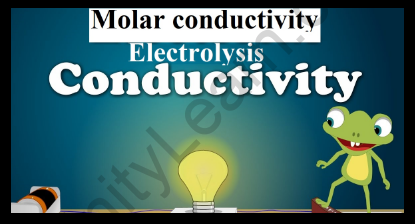Table of Contents

Introduction
Molar conductivity is the conductance property of a solution containing one mole of electrolyte, and it is a function of the solution’s ionic strength or salt concentration.
To put it another way, molar conductivity is the total conducting power of all the ions generated when a mole of electrolyte is dissolved in a solution. Molar conductivity is a property of an electrolyte solution that is used to determine an electrolyte’s efficiency in conducting electricity in a solution.
The Formula for Molar Conductivity
Molar conductivity is mathematically represented by the following expression.
Λm = K / C
Where K is the specific conductivity and c is the mole per litre concentration.
The molar conductivity of an electrolytic solution is defined as the conductance of a volume of solution containing a unit mole of electrolyte that is placed between two electrodes of a cross-section of a unit area or at a distance of one cm apart
Sm2mol-1 is the unit of molar conductivity.
Concentration Affects Molar Conductivity
The molar conductivity of both weak and strong electrolytes increases as concentration or dilution is reduced. The conductivity supplied by one mole of ions is known as molar conductivity. We’re still working with the same unit mole of ions after dilution. Increased dilution, on the other hand, causes more electrolytes to dissociate into ions, resulting in a greater number of active ions in the solution. These active ions provide more conductivity.
Specific conductivity is determined by the number of ions in a unit volume of solution. The amount of current-carrying ions in the solution increases as the dissociation increases with dilution. Dilution, on the other hand, decreases the number of ions in a given volume of solution. As a result of this, the conductivity decreases.
Specific Conductivity is the measure of how well something conducts electricity
The conductance of an electrolytic solution is defined as the ability of a sample to carry an electric current. The resistance of an electrolytic solution is defined as the amount of resistance it has to the flow of electric current. The conductance of that particular electrolytic solution is, of course, the reciprocal of its resistance. Conductance is measured in SI units of S. (Siemens).
FAQs
Molar conductivity is a term used to describe the ability of a substance to conduct electricity when it is?
Molar conductivity is the conductance property of a solution containing one mole of electrolyte, and it is a function of the solution's ionic strength or salt concentration.
How do molar conductance and specific conductance relate to one other?
Specific conductance is obtained by multiplying the molarity of the solution by the molar conductance of the solution.
Q: What relationship exists between molar conductance and dilution? How does it change as the solution’s conductance changes?
Ans: The amount of ions responsible for transporting current reduces when the solution is diluted per unit volume. As a result, as dilution increases, conductivity diminishes. Molar conductivity, on the other hand, rises with dilution.
K/M = molar conductance
K stands for specific conductance.
M is the electrolyte concentration.







